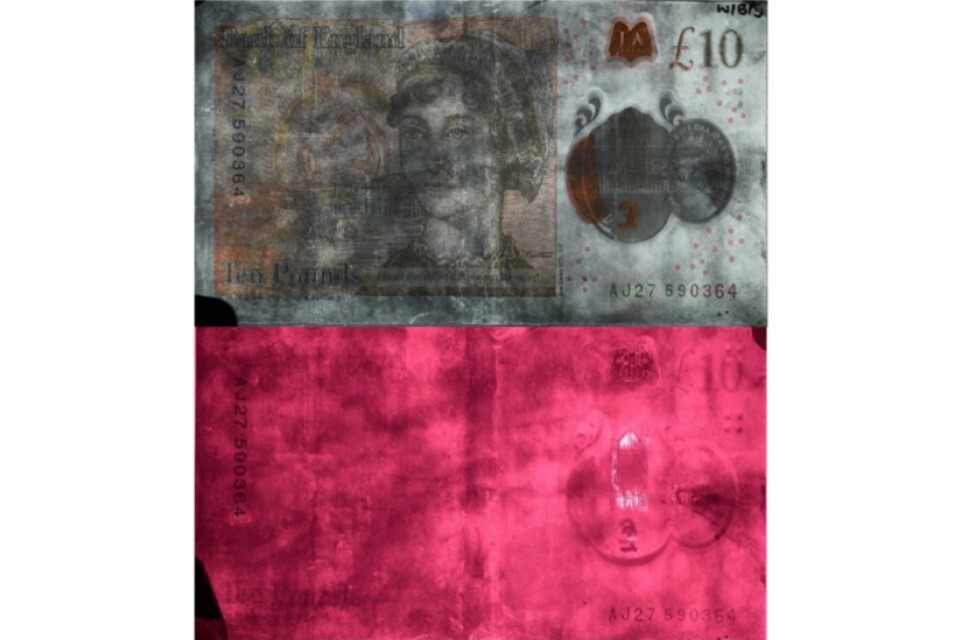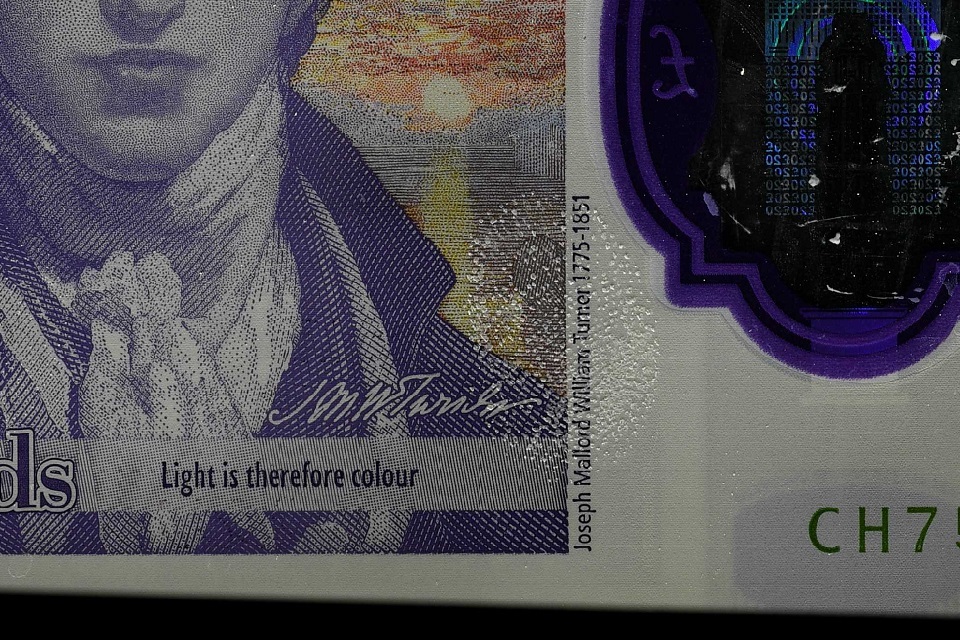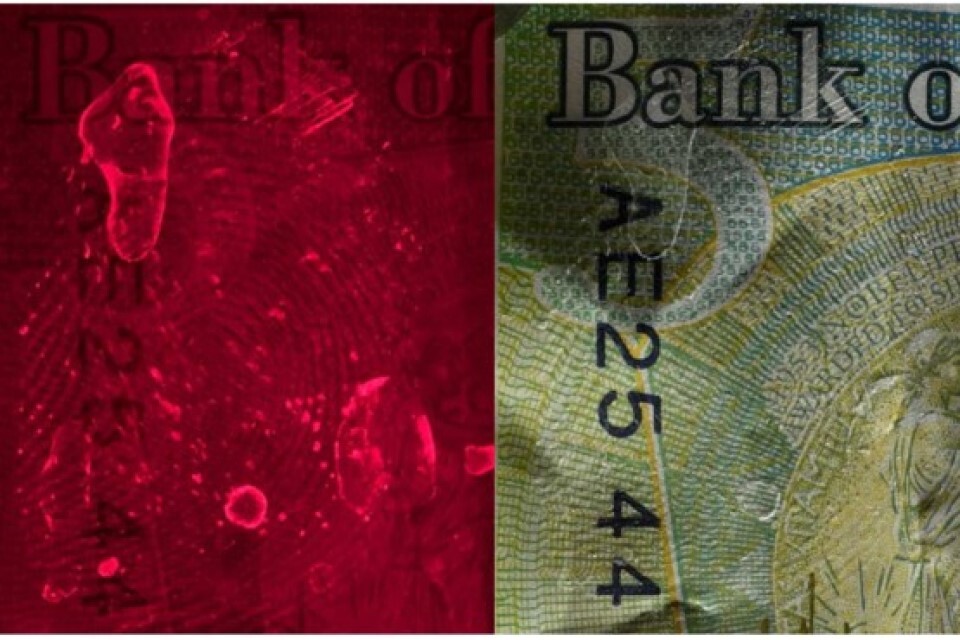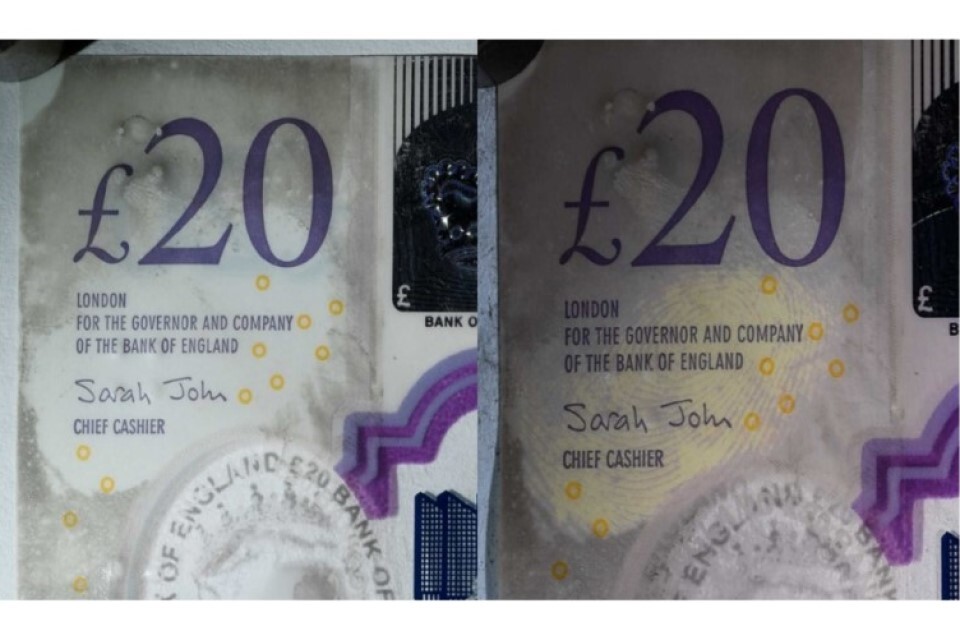Circulated polymer banknotes: fingermark visualisation research
Published 31 January 2024
This guidance also forms part of the second edition of the Fingermark Visualisation Manual (FVM). Further research has since been completed on circulated polymer banknotes.
As the initial research only focussed on uncirculated £5 and £10 notes, the Defence Science and Technology Laboratory (Dstl) has conducted additional work to ensure this guidance is still fit for purpose now that all denominations are in circulation.
1. Approach
120 banknotes (30 of each denomination) were obtained randomly from circulation for the comparison of 5 sequences (Figure 1). The FVM processing instructions were followed and developed fingermarks were viewed with white light, reflected Infrared (IR) and/or reflected Ultraviolet (UV).

Figure 1: Five processing sequences used in the study
Sequence 1:
- Black Magnetic Powder (BMP)
- Powder Suspension (PS)
Sequence 2:
- Vacuum Metal Deposition (VMD) (Gold/Zinc)
- Vacuum Metal Deposition (VMD) (Silver)
- Superglue (SG)
Sequence 3:
- Powder Suspension (PS)
Sequence 4:
- Superglue (SG)
- Black Magnetic Powder (BMP)
Sequence 5:
- Superglue (SG)
- Vacuum Metal Deposition (VMD) (Gold/Zinc)
- Vacuum Metal Deposition (VMD) (Silver)
The experimental design utilised 3 ages of planted marks (1 day, 1 week and 1 month), from 16 donors for each of the 5 sequences. This equated to 192 fingermarks per sequence, spread across the 4 denominations of banknotes ~ 960 fingermarks in total.
Fingermarks were assessed using the grading scheme outlined in Table 1, based on the quality of the ridge detail present.
Table 1: Fingermark grading scheme
| Grade | Level of detail |
|---|---|
| 0 | No evidence of a fingermark |
| 1 | Evidence of contact but no fingermark ridge detail |
| 2 | Less than 1/3 of the fingermark ridge detail is present |
| 3 | 1/3 to 2/3 of the fingermark ridge detail is present |
| 4 | Over 2/3 of the fingermark ridge detail is present |
2. Results
Only the fingermarks that were graded 3 and 4 have been included in the analysis of the results as these are generally considered to be of identifiable quality.
The graph in Figure 2 shows the number of fingermarks graded 3 and 4 based on the age of the mark and the sequence. This shows the most effective sequence tested was Black Magnetic Powder (BMP) followed by Powder Suspension (PS) (sequence 1).

Figure 2: Number of 3 and 4 graded fingermarks based on age and sequence
However, in this sequence, the number of additional fingermarks visualised by Powder Suspension was negligible.
The 2 sequences combining vacuum metal deposition (VMD) and Superglue (2 and 5) were also effective at developing grade 3 and 4 marks. These two processes, along with Powder Suspension, were similar in performance when used as a single chemical treatment (Figure 3).

Figure 3: Number of 3 and 4 graded fingermarks for a single process based on age
3. Observations
When conducting the research, key observations in relation to the processes and substrates were noted and a few examples are shown below.
Although the combined results show BMP and PS to be the most effective sequence, these processes did not always provide fingermarks with good contrast as a high level of background staining was observed on a few of the samples (Figure 4). The cause of this has not been determined due to the unknown history of the circulated banknotes.

Figure 4: £10 banknote treated with PS showing areas of high background staining. Imaged with white light (top) and reflected IR (bottom)
Whilst Superglue was effective, many marks developed were poor quality, with a dotty appearance and lack of continuous ridge flow (Figure 5).

Figure 5: £20 banknote treated with SG on marks aged for 1 month, showing a dotty appearance
The use of reflected UV was found to be beneficial for imaging Superglue treated banknotes as it reduced the background interference providing a better contrast (Figure 6).

Figure 6: £5 banknote treated with SG, imaged with reflected UV (left) and oblique white light (right)
When processing the banknotes with VMD, gold followed by zinc left a considerable number of empty marks, and subsequent treatment with silver VMD was always required to improve the development (Figure 7).

Figure 7: £20 banknote treated with VMD gold/zinc (left) showing ‘empty marks’ and following additional VMD silver treatment (right) showing ridge detail developed
4. Conclusions
The results of the study concur with the original research conducted on the Bank of England polymer banknotes by the team whereby BMP was the most effective as a single process, and was used in the most effective sequence. This study supports the current guidelines in the FVM (Figure 8), however, the following considerations and conclusions are highlighted below:
- There were some issues with background staining for both BMP and PS
- PS, VMD and Superglue were similar in effectiveness when used as a single process on circulated notes, however a larger study would be needed to determine if one of these was superior. VMD is removed before superglue in Chart 1.7 as it is included as an option under superglue fuming enhancement techniques instead.
- Reflected UV should be used with Superglue to give optimum contrast.
- The processing chart (1.7) in the FVM is a two-bar maturity and the optimum treatment may vary depending on the history of the banknote. As this is unknown, close observation of development during treatment is required to avoid background staining. Monitoring trends in laboratory recovery rates to identify issues is advised.

Figure 8: Chart 1.7 Currency (Polymeric) from the Fingermark Visualisation Manual 2nd Edition, 2022
This flowchart shows a sequence:
- Visual examination
- Fluorescence examination
- A step that has been removed - Vacuum Metal Deposition
- Powders
- Two alternative paths. Either: Superglue fuming followed by Superglue fuming enhancement, or (generally the most effective sequence) powder suspension
- Both paths converge on the same final step: Lipid Dyes (Basic Violet 3)
